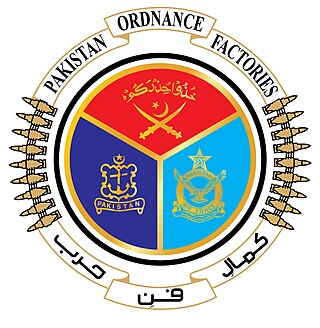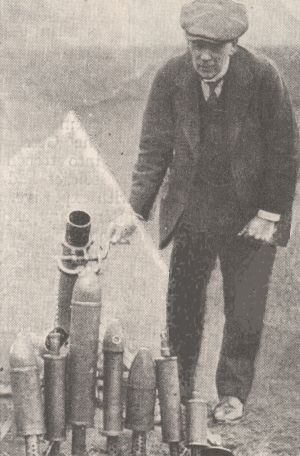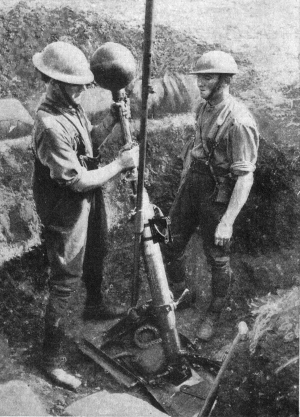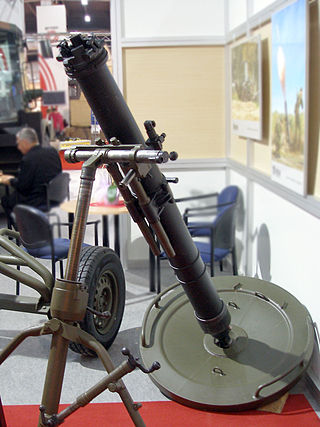Related Research Articles

A mortar is usually a simple, lightweight, man-portable, muzzle-loaded weapon, consisting of a smooth-bore metal tube fixed to a base plate with a lightweight bipod mount and a sight. Mortars launch explosive shells in high-arching ballistic trajectories. Mortars are typically used as indirect fire weapons for close fire support with a variety of ammunition.

A shell, in a military context, is a projectile whose payload contains an explosive, incendiary, or other chemical filling. Originally it was called a bombshell, but "shell" has come to be unambiguous in a military context. A shell can hold a tracer.

The M224 60 mm Lightweight Company Mortar System (LWCMS) is a smooth bore, muzzle-loading, high-angle-of-fire mortar used for close-in support of ground troops. It was deployed extensively in the War in Afghanistan by the United States military.

The M252 81 mm medium weight mortar is a British-designed smooth bore, muzzle-loading, high-angle-of-fire weapon used for long-range indirect fire support to light infantry, air assault, and airborne units across the entire front of a battalion zone of influence. In the U.S. Army and U.S. Marine Corps, it is normally deployed in the mortar platoon of an infantry battalion.

The Type 11 70 mm infantry mortar, was a muzzle-loading, rifled bore infantry mortar used by the Japanese. The Type 11 designation was given to this gun as it was accepted in the 11th year of Emperor Taishō's reign (1922). It was first used in 1922 and was the first mortar to be introduced by the Imperial Japanese Army. The Type 11 was later replaced by the Type 92 battalion gun.

The L118 light gun is a 105 mm towed howitzer. It was originally designed and produced in the United Kingdom for the British Army in the 1970s. It has since been widely exported. The L119 and the United States Army's M119 are variants that use a different type of ammunition.

The Ordnance SBML two-inch mortar, or more commonly, just "two-inch mortar", was a British mortar issued to the British Army and the Commonwealth armies, that saw use during the Second World War and later.

The Pakistan Ordnance Factories (POF) is a major firearms and a defence contractor headquartered in Wah Cantt, Punjab, Pakistan. Described as "the largest defence industrial complex under the Ministry of Defence Production, producing conventional arms and ammunition to the international standards" by the Government of Pakistan.

The Brandt 60 mm Long Range gun-mortar is a breech loading mortar capable of firing on a flat trajectory. It was developed from the Brandt Mle CM60A1 and resembles a long-barrelled, long-ranged variant of that weapon.

The M2 mortar is a 60 millimeter smoothbore, muzzle-loading, high-angle-of-fire weapon used by U.S. forces in World War II, the Korean War, and the Vietnam War for light infantry support.

The Stokes mortar was a British trench mortar designed by Sir Wilfred Stokes KBE that was issued to the British and U.S. armies, as well as the Portuguese Expeditionary Corps, during the latter half of the First World War. The 3-inch trench mortar is a smooth-bore, muzzle-loading weapon for high angles of fire. Although it is called a 3-inch mortar, its bore is actually 3.2 inches or 81 mm.

The Newton 6-inch mortar was the standard British medium mortar in World War I from early 1917 onwards.

The 2 inch medium trench mortar, also known as the 2-inch howitzer, and nicknamed the "toffee apple" or "plum pudding" mortar, was a British smooth bore muzzle loading (SBML) medium trench mortar in use in World War I from mid-1915 to mid-1917. The designation "2-inch" refers to the mortar barrel, into which only the 22 in (560 mm) bomb shaft but not the bomb itself was inserted; the spherical bomb itself was actually 9 in (230 mm) in diameter and weighed 42 lb (19 kg), hence this weapon is more comparable to a standard mortar of approximately 5–6 in (130–150 mm) bore.

The 240 mm trench mortar, or Mortier de 240 mm, was a large calibre mortar of World War I. An original French design, it was developed by Batignolles Company of Paris and introduced in 1915.

An artillery fuze or fuse is the type of munition fuze used with artillery munitions, typically projectiles fired by guns, howitzers and mortars. A fuze is a device that initiates an explosive function in a munition, most commonly causing it to detonate or release its contents, when its activation conditions are met. This action typically occurs a preset time after firing, or on physical contact with or detected proximity to the ground, a structure or other target. Fuze, a variant of fuse, is the official NATO spelling.

The M6 Mortar is a 60 mm lightweight infantry mortar made by Hirtenberger AG of Austria.

The number 106 fuze was the first British instantaneous percussion artillery fuze, first tested in action in late 1916 and deployed in volume in early 1917.

The Type 2 12 cm mortar is a smooth bore, muzzle-loading type mortar which, except for the firing mechanism, closely resembles the conventional Stokes-Brandt 81 mm mortar. The bipod and cradle of the two types of mortars are identical, except for size and the fact that the bipod legs can be removed as a unit from the cradle of the 120 mm mortar. The large, ribbed base plate has only one socket for the spherical projection on the barrel. A Type 2 120 mm mortar was reported captured at Leyte. The Type 2 120 mm mortar was considered an effective mortar by the Imperial Japanese Army; however, its production only commenced during the latter half of WWII, and its overall service action was limited.

The 120mm М95 Long Range Mortar is a 120 mm (4.7 in) mortar that was developed by Serbian Military Technical Institute. It is long-range and heavier mortar compared to the light mortar 120mm M75 and represents further development of Universal Mortar UB M52.
References
- ↑ "Contract Notice Supply of 60mm Mortar Barrels". European Defence Agency.
- ↑ "British Army Vehicles and Equipment" (PDF). MoD. Archived from the original (PDF) on 2010-11-19.